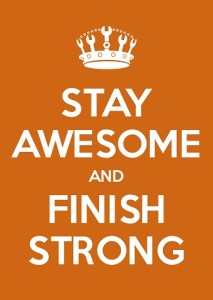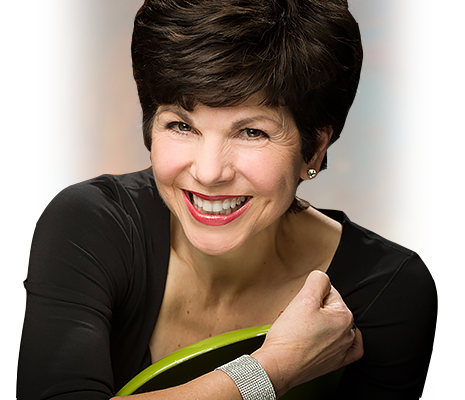
This is the first part of a four-part series exploring the many ways in which you can close your presentations with greater impact.
Each week, I will share three or four different techniques to help you bring your presentation to a purposeful end. We’ll look at video examples from TED.com and YouTube and see how other professionals and expert speakers use these closing techniques with success.
I created this teaching content as part of a year-long Presentation Academy for the sales team of a valued client in the financial services sector. This was our final teaching module. We wanted to finish strong, so we made it our theme and focus.
Why is your presentation closing so important?
The two most memorable times during a presentation for an audience is at the beginning and at the end. That is because of the power of Primacy and Recency. Studies have shown the first thing (primacy) and last thing (recency) you communicate to your audience will have higher propensity for recall. This is why your presentation opening and closing comments are so vital. They are sticky moments in your high-engagement presentation. Make the most of them.
“Your audience may likely remember best what you said last.”– Deborah Grayson Riegel
Guidelines about presentation closings
Before we dive into the different techniques, let’s review some guidelines that pertain to your closing remarks:
- Avoid the weak wind-down
- End “naked”
- You get the last word
- Practice your closing remarks ahead of time
- Have a contingency plan
In Part 1 of this four-part series, let me expound on two of these five guidelines for effective presentation closings:
1. What is the weak wind-down and why should you avoid it?
The close is the second most important section in your presentation. Because it’s at the end, many presenters forget to think about how they’re going to close their presentation. They simply let it happen by running out of time or asking a throwaway question such as, “Are there any questions?” Don’t let your presentation close by itself. End solidly and with purposeful intent. Demonstrate one more time that you are an expert in your field and clearly in charge of your presentation. Keep your energy up through to the very end of the presentation. And remember, no rambling or mumbling when you deliver your close. Be purposeful and deliberate.
2. What do I mean by ending naked?
Begin and end without PowerPoint slides. Even if you are using some slides during your presentation, you should always start and end “naked.” That is, it’s just you and the audience. You don’t need a title slide to open your presentation. You are the title slide. You are also the closing slide. Your live presence in the room is all they need to see, hear, feel, and experience. Take center stage and fill the room with your energy, ideas, expertise, and passion. If you simply must have one more PowerPoint slide, then post your contact details on the final slide.
I’ll discuss more about the guidelines in Part 2 of this blog series. Now, let’s move on to exploring specific presentation closing techniques that you can use in your presentations.
Experiment with these different presentation closing techniques
#1: The traditional close
At a Glance: The traditional close is essentially a review of the benefits. This is not to be confused with the old and worn out advice from Aristotle of “Tell them what you are going to tell them, tell them, then tell them what you told them.” Your closing remarks should be more strategic than a rehashing of the content. Your job at the close is to recap the key message. Using this technique, your closing comments should be brief and concise. They should be straightforward, no frills, but full of conviction. Often the traditional close will begin with the set up phrase, “In conclusion,” and usually end with the phrase, “Thank you.”
Video Example: Robert Full’s 2002 TED.com talk on bio-mimicry, entitled: “Robots inspired by cockroach ingenuity.” Here are the words he passionately shares at the end of his presentation: “So, in conclusion, I think the message is clear. If you need a message, if nature’s not enough, if you care about search and rescue, or mine clearance, or medicine, or the various things we’re working on, we must preserve nature’s designs, otherwise these secrets will be lost forever. Thank you.”
To view Robert’s closing statement, advance his video to time code 19:48-20:05
Coaching tip for Robert Full: Next time he should “end naked.” His final slide was cluttered with words (including a typo) and four images. It was visually distracting. He should go to a black screen and have the audience focus only on him and his powerful closing comments. He might also try to put a little more space between his final phrase and his thank you. “…otherwise these secrets will be lost forever.” [1-2 second pause] “Thank you.”
#2 Leave them with a conundrum
At a Glance: The conundrum closing technique uses a deep, thought-provoking question for your audience to ponder. A conundrum is a difficult problem to figure out, or a riddle or dilemma. You pose the conundrum and then give them a way to respond to you with their answers after the presentation. Some people will be so intrigued that they will be compelled to get in touch with you to either find out the answer or share their thoughts on the matter.
Written Example: Fiona Wilson, then Professor of Simmons School of Management in Boston MA, used the conundrum close during her 2007 keynote speech at the Connecticut Women’s Council event. Her closing words were:
“If the higher purpose of medicine is health, and the higher purpose of law is justice, then what is the higher purpose of business?”
You can use the same two high level concepts of medicine and law, and then change the third (business) to a high-level concept related to your topic. Remember to pause after finishing the conundrum to give your audience time to reflect upon the question.
Coaching tip for Fiona Wilson: Be sure to share your contact details with your audience at the end of your presentation, especially if you use the conundrum close. You posed such a compelling question that certain people in the audience (people like me) will go crazy thinking about your question and will want to get in touch with you. Make it easy for them to find you with a final visual slide with your contact details (telephone, email, and social media URL)
#3 Motivating quote close
At a Glance: Memorize the quote and practice speaking it out loud with dramatic effect. Remember to take your time when speaking a closing quote. Never rush it, as you risk slurring the words or changing the order of the words. If you like, you can complement the spoken quote with a provocative visual image, but be careful not to print the quote text on the slide, as the audience will be drawn to read the slide and not listen to you. You don’t want PowerPoint to have the final word.
Video Example: Al Gore in his 2009 TED talk, “What comes after an inconvenient truth?” uses an African proverb to close. Notice how he adds his two cents on the tail end of the proverb to tie back into his call-to-action. Here are the specific words he shares in his closing remarks: “There is an old African proverb that says, ‘If you want to go quickly, go alone. If you want to go far, go together.’ [pause] We need to go far, quickly. Thank you very much.”
To view the closing statement, advance the video to time code 7:25-7:39
Coaching tip for Al Gore: You appear to be in a bit of rush with your closing comments. Perhaps you were running over time? Your message is powerful and important, so my advice to you is to take your time with your close. Bring your full vocal awareness to these closing comments. An extra 5 seconds in your delivery could make a meaningful difference in how your motivating call-to-action embeds in your audience’s head, heart, and soul.
Preview of Part 2
Next week, I’ll expound on the idea of why you should have the last word in your presentation (guideline #3). I’ll also share with you three more closing techniques, including:
#4 – the WWW close
#5 – Physical props to create a lasting visual memory
#6 – Metaphor close
Increase your presentation closing confidence
Henceforth, I’d like you to pay more attention to how other people close their presentations. You can observe closing techniques in live presentations, virtual presentations, or on video recorded presentations on TED.com, YouTube, or other social media sites. See if you can identify what the speaker is doing and how it might work for you and your presentation topic. Then use these new ideas to broaden your repertoire of presentation closings. You are now a student of presentations.
Need help with your presentations?
Contact Kathy McAfee, Executive Presentation Coach and Trainer at or email her at Kathy@AmericasMarketingMotivator.com
Check out these professional services available to you and your organization – http://www.americasmarketingmotivator.com/services/motivated-presenters//

